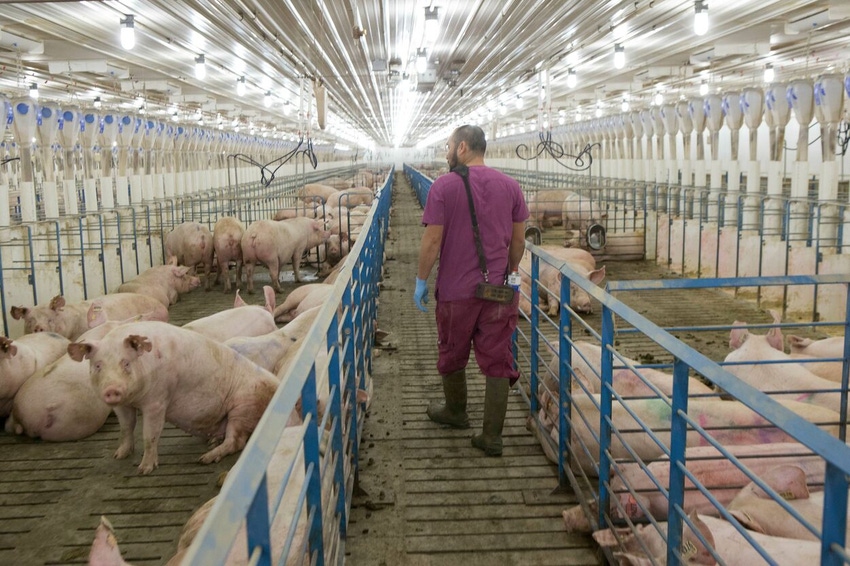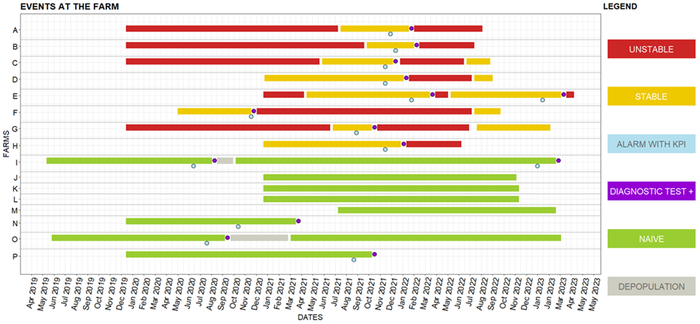Utilizing swine field data to early identify signals of disease
Data sources help to identify drivers of post-weaning mortality in sow farms.

Diverse and large-scale data streams are abundant in the modern swine industry. However, this data is not commonly integrated, hindering the ability to investigate the impact of diseases on productivity, revealing the risk factors for disease outbreaks in sow farms, or uncovering the drivers of wean-to-finish performance. The development of data platforms to combine and analyze available data streams from commercial flows supports leaders in taking data-driven decisions concerning swine health and performance.
Recently, our group developed a combination of tools to support producers in making precision swine health and productivity management a reality. One example is the ongoing monitoring of sow farm data to early-identify deviations caused by porcine reproductive and respiratory syndrome virus outbreaks. Another example is integrating and analyzing multiple data streams related to the pre-weaning phase and stocking conditions to identify and measure the drivers of post-weaning mortality and forecast downstream nursery mortality of weaned groups.
Using production data and off-feed events to detect early signs of PRRSV sow farm outbreaks
PRRSv infection is characterized by significant changes in production indicators and animal behavior in sow farms. These changes occur in indicators such as the number of dead sows, the number of abortions, preweaning mortality or the number of sows off-feed events, to name a few. Therefore, implementing an automated system to monitor such data allows the detection of productivity deviations associated with disease outbreaks, thus triggering early disease investigation by decision-makers. We created a tool that integrates multiple data sources in different formats. The process of sending the data, analyzing it and sending the reports is fully automated. Every time the models raise alarms, an email is sent to the farm's assigned contacts.
This tool focuses on monitoring weekly productivity data collected from recording keeping systems, feed intake data collected from sow electronic feeding systems, and diagnostics. Instead of monitoring single parameters, both univariate and multivariate models were tested using different production indicators. Exponentially weighted moving average, cumulative sum, multivariate cumulative sum and multivariate exponentially weighted moving average were used to determine early detection and time to detect disease (time between the week the model raised the alarm and the week the processing fluids turned positive for PRRSv).
For the univariate models, it was observed that the number of abortions had the highest early detection (79%, 11/14), with the model raising alarms on average 3.7 weeks before the processing fluids turned positive. Concerning the multivariate models, these had a higher early detection, with both models using weekly PWM% with neonatal losses% raising alarms early in 13/14 outbreaks (93%), with the models raising alarms on average 4 weeks before the processing fluids turned positive. Figure 1 illustrates the early detection using the indicators compared to the diagnostic results.
The study enhances the importance of looking at different data sources to detect early deviations in the indicators potentially associated with disease outbreaks and to test models to maximize performance for each indicator. Early investigation allows the decision-makers to plan disease control and elimination strategies within their systems.

ISU Figure 1: Summary of the farm status and events between April 2019 and May 2023. The red color represents status one mentioned in this report as unstable, the yellow color represents status two and status 2vx mentioned in this report as stable, the green color represents PRRSv naïve farms, the grey color represents depopulation, the purple color represents the week in which the processing fluids results turned PRRSV positive, the blue color represents the week in which a key production indicator had an alarm.
Predictors of Swine Performance platform – Forecasting nursery mortality
The Predictors of Swine Performance is a system-specific platform to automate the comprehensive integration of multiple data within one swine production system. Once the algorithms are built to combine whole herd data into a master table, statistical modeling is applied on three approaches:
Integrate two to three years of retrospective birth-to-market data from closeouts of pigs and identify the major risk factors associated with wean-to-finish mortality. This "whole-herd" approach allows measuring the impact of factors such as disease status from the sow farms originating the cohorts of marketed pigs on the mortality. Notably, a study utilizing this whole-herd approach demonstrated that weaned groups with young weaning age, high pre-weaning mortality and challenged with either PRRS and/or M. hyopneumoniae s had higher wean-to-finish mortalities compared to groups without these characteristics (Magalhaes et al., 2022).
Causal inference analysis of the most relevant factors identified in the previous step. This approach utilizes statistical methods that control and balance confounders' effects when estimating the impact of specific factors. For instance, causal inference analysis is more accurate in measuring the impact of specific factors compared to just comparing the raw means of groups challenged or not by specific diseases, for example, in contrast to the common raw mean comparison.
Forecasting grow-finish mortality of weaned groups utilizing pre-weaning phase productivity and health data and their conditions at placement in growing sites (i.e., stocking density, number of sources, infrastructure characteristics, for example). A recent analysis demonstrated a prediction accuracy of 78.87% for predicting nursery groups that would have high nursery mortality (Magalhaes et al., 2023).
In conclusion, both studies enhance the importance of looking at different data sources to help the production systems, either by monitoring indicators to detect early deviations in indicators potentially associated with disease outbreaks or by predicting PRRSv's impact on the production system.
Swine producers, veterinarians and producers interested in participating in the program, please get in touch with our team Mafalda or Edison.
Acknowledgments
These studies were funded by the USDA - National Institute of Food and Agriculture #022-68014-36668 and #2023-68008-39860, the American Association of Swine Veterinarians Foundation and the Iowa State University Office of the Vice President for Research seed grant.
References
Magalhaes, E.S.; Zhang, D.; Wang, C.; Thomas, P.; Moura, C.A.A.; Holtkamp, D.J.; Trevisan, G.; Rademacher, C.; Silva, G.S.; Linhares, D.C.L. Field Implementation of Forecasting Models for Predicting Nursery Mortality in a Midwestern US Swine Production System. Animals 2023, 13, 2412. https://doi.org/10.3390/ani13152412
Magalhaes ES, Zimmerman JJ, Thomas P, Moura CAA, Trevisan G, Holtkamp DJ, Wang C, Rademacher C, Silva GS, Linhares DCL. Whole-herd risk factors associated with wean-to-finish mortality under the conditions of a Midwestern USA swine production system. Preventive Veterinary Medicine. 2021a; 198:105545. https://doi.org/10.1016/j.prevetmed.2021.105545.
About the Author(s)
You May Also Like



